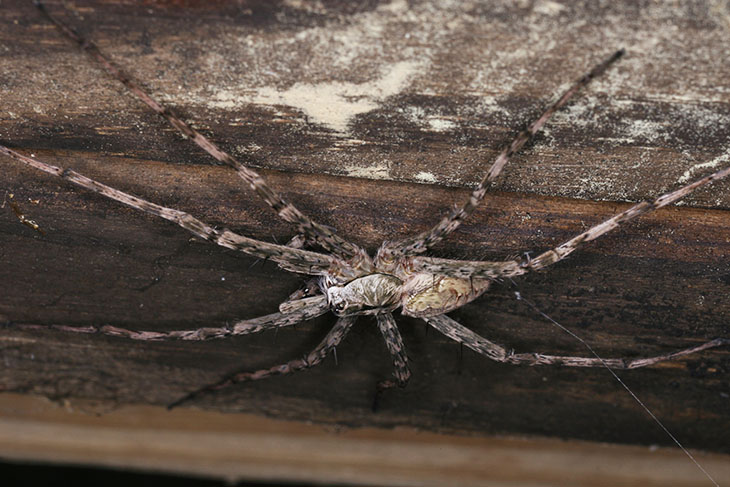
And so, we rejoin our hero in his further adventures of spider encounters and arachnophobia…
When I did the detailed portraits of a largish wolf spider (family Lycosidae) a few days back, I released it under the porch steps and vowed to keep an eye open. Accommodatingly, the spider assisted this endeavor by molting sometime in the next 12 hours or so, leaving behind the old exoskeleton almost exactly where it had disappeared from my sight. About a day after that, casually, I started looking around under the steps to see if, by any chance, I could spot it again, and found it perched only centimeters away from the exoskeleton, almost in plain sight. This was an open invitation as far as I’m concerned.
I went in and got the ringflash, the most dependable way to try and elicit a reflection from the eyes while close enough for detail. It takes a very narrow angle between light and receiver, which is usually your eyes, but in this case the camera lens. What typically happens is, you can spot a reflection at night from a moderate distance if a bright flashlight is held close to your eyes, but the reflection will vanish as you get closer. While I have had some success with the ringflash (a circular flashtube that goes around the lens itself,) at macro distances even this tiny difference between light and receiver is enough to eliminate the reflection. I got the barest evidence of it, but nothing that showed as distinctly as I would have liked.
[Someday I will try a different trick, which is to set up a piece of glass angled at 45°, right in front of the lens so I am shooting through it, and fire off a flash unit aimed at the glass, perpendicular to the lens. This will bounce the light on a path directly from the lens, and may produce the effect I’m after. This will be a fussy rig to construct, however, and for very limited uses, so it hasn’t happened yet…]
After doing the establishing shot above, I decided to attempt what I had skipped over the previous time, which was to have the spider walk across my palm, and preferably get a shot of it perched there. This has four purposes: to show scale, to creep people out, to demonstrate the harmlessness of wolf spiders, and to help me get over my lingering arachnophobia. It’s something I’ve had since childhood, and I think irrational fears should be eliminated, so I’ve been working casually towards this end, not always effectively. So, adjusting the camera settings and focus for my palm, I set it down nearby, put my hand palm-up next to the spider, and started nudging it in that direction.
We pause here for dramatic effect, while I relate the size of the spider. Using methods soon to be revealed, I determined that the spider was about 25mm (1 inch) in body length, which puts the leg spread over 100mm (4 inches) – I’ve seen bigger, but you have to admit it’s impressive nonetheless. The spider was already a little concerned over the various angles and close approaches from the various photos I’d already taken, but had remained motionless, relying on its camouflage. As my fingers touched it, however, it was made aware that its cover was blown, and instead of nicely, calmly, walking onto my hand in a casual and nonthreatening manner, it scrambled across at quite high speed. The ‘conquering irrational fears’ thing only goes so far, and I flinched sharply, causing the spider to launch itself on a dragline off of my hand and down to my feet. There, I was fine with it, and was even embarrassed with myself for flinching, but I can attest personally that, no matter what the rational mind wants to say, the place where the phobias lie still has the first word.
It really is peculiar. I know the bite of a wolf spider is harmless, far less than a bee’s sting, and I’ve been stung by those too many times to care much. But the spider thing still makes me react. A few days later, I coaxed a stag beetle onto my hand to show The Girlfriend, despite the prominent pincers plainly visible, and didn’t have the slightest issue with it. Spiders just don’t move right, and have too (two) many legs. So I’m sympathetic towards phobias, to a limited extent – at the point where people feel they have to kill every spider (or snake) they see is the point where they’re letting the phobia dictate actions beyond the reflexive; It’s useful to remind oneself that this is an irrational fear, and not a justification.
Anyway, after this failed therapy, I gathered in the molted exoskeleton for some detail shots. It was interesting to note that the exoskeleton over the abdomen has shriveled up into a twisted thread, making the remains look much less significant – here’s a scale shot on a penny:
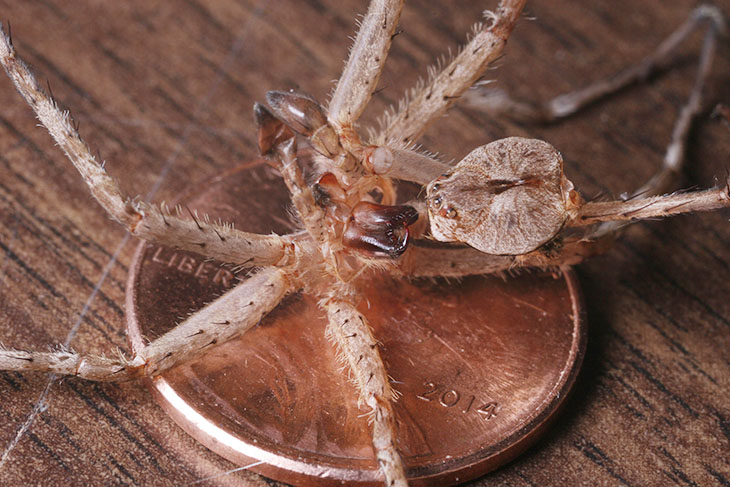
Not terribly impressive there, is it? Note how the ‘skullcap’ upper half of the cephalothorax has separated from the chelicerae and pedipalps seen in the center – that’s typical of this species, and indeed, many arthropods including some crabs. Others, like mantids, split longitudinally down the ‘spine.’ But since I hadn’t brought out the calipers for the live specimen, I was able to measure the molted cephalothorax, and use that (and a photo of a ruler superimposed on the fullbody image above) to determine the body length overall. To be honest, the spider was even bigger, since they always emerge larger than the molted skin, but we’ll go with the measurements I gave anyway.
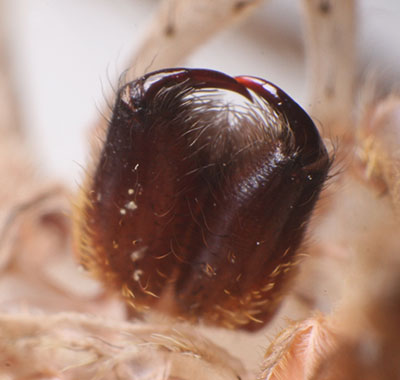 You might remember these from the earlier post – they are, of course the fangs (chelicerae.) Curiously, every species where I’ve been able to see these, regardless of the coloration on the body, displays this same deep reddish-brown hue. I know I’m not helping anyone’s own arachnophobia by posting these so prominently, but they’re cool anyway – you can see just how small they are in the previous pic. For many a bug, this is the last thing they saw – well, okay, considering the compound eyes, it would be this, and the ground, and the sky, and the plant they were on, and the zit on their back…
You might remember these from the earlier post – they are, of course the fangs (chelicerae.) Curiously, every species where I’ve been able to see these, regardless of the coloration on the body, displays this same deep reddish-brown hue. I know I’m not helping anyone’s own arachnophobia by posting these so prominently, but they’re cool anyway – you can see just how small they are in the previous pic. For many a bug, this is the last thing they saw – well, okay, considering the compound eyes, it would be this, and the ground, and the sky, and the plant they were on, and the zit on their back…
A few days later, while watering the front garden where the mantis lives late at night, I scared up another wolf spider, much smaller than the first subject, but special in her own way. Even from a distance, the shape of the abdomen looked suspicious, and bringing out the penlight I always carry (you’d be amazed how often it’s useful when you always have it on hand,) I confirmed my suspicions: she was carrying her brood on her abdomen, as wolf spiders tend to do.
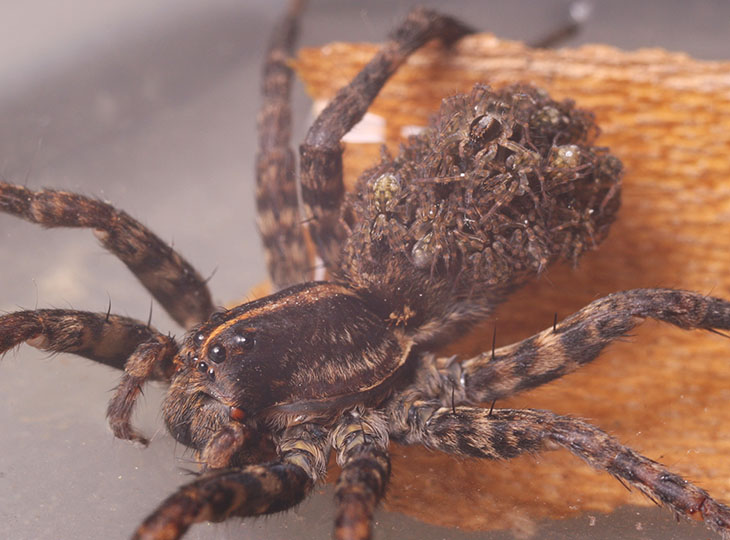
Aren’t they just adorable? Their cute teeny-weeny wittle legs, and those button eyes – yeah, I know, you can’t really see the eyes, since the young have the instinct to keep their heads pointed inwards and bunch their legs up as protective armor.
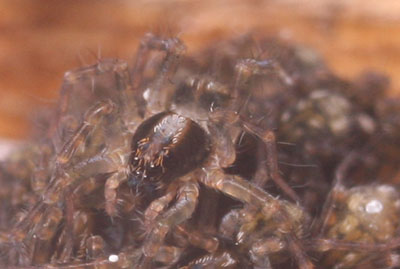 Except for this one. Brazenly exposed up on top of the stack, it takes advantage of the best view and the freshest air, perhaps serving as lookout or hall monitor, or maybe some purpose akin to the guy who drives the back end of the hook-n-ladder truck (didn’t you always want to do that? Whaddya mean, “The what?” Just how young are you?)
Except for this one. Brazenly exposed up on top of the stack, it takes advantage of the best view and the freshest air, perhaps serving as lookout or hall monitor, or maybe some purpose akin to the guy who drives the back end of the hook-n-ladder truck (didn’t you always want to do that? Whaddya mean, “The what?” Just how young are you?)
I have wanted to do some detail shots of young ones like this all by themselves, but that would entail separating them from their mother – while the cruelty aspect has a little to do with my hesitation, it’s much more that I’m not sure I could do it without injuring them (since I doubt there’s really any emotional trauma that could occur – extending what we would feel to arthropods is not exactly sciencey.) There are two things that I’m curious about when seeing this, by the way. The first is wondering just how long they remain with momma before venturing out on their own, or even whether they hang on until she dies – it’s not uncommon for adults to pass on after reproducing, and likely happened to the green lynx spiders I watched last year. Second, I wonder if, and how, they feed when riding piggyback. The mother might be able to snag an insect and offer it to them, but she certainly isn’t going to feed them any other way, and I suspect they’re just on their own in that department. So what does riding with mamma do? Is it only protection for a few days?
Oh, you want another baby pic? Okay.
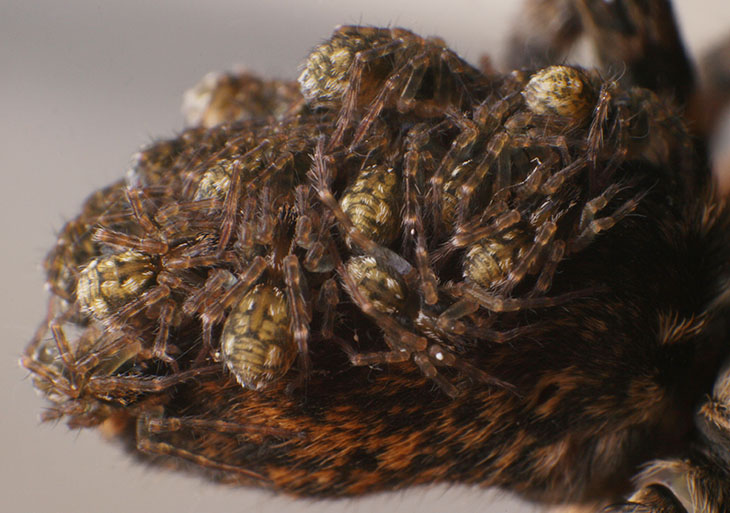
Notice how nobody’s eyes are visible, and the legs are bunched up tightly to shield their bodies. I’m a little surprised the abdomens are left so open, though.
No, we’re not done yet.
The yard plays home to a lot of this species, known as orchard orbweavers (Leucauge venusta.) They’re small, only about 10mm in body length, and generally unobtrusive. This couple was a-courtin’ on the same chive plants that I posed the wolf spider on earlier.

The male is on the left, the female on the right – I only know this because I could see the difference in pedipalps; the coloration is variable and likely not an indication at all. While in many species the female is significantly larger than the male, in this one (and the wolf spiders) the difference is minimal. Following a successful mating (which is always an iffy thing,) the female’s abdomen will swell with eggs before she deposits them in an egg sac. Now, there was no evidence of this to be seen on the chive plants, but alongside the front door where I watched another courtship take place, the female produced an egg sac pretty quickly.
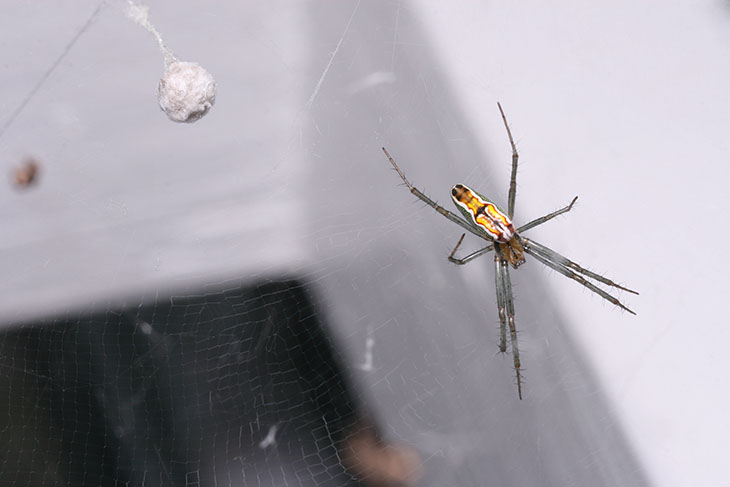
I had initially believed this to be another orchard orbweaver, but a closer look at that color pattern showed that they didn’t match, and I started searching through BugGuide.net. Having no luck, I finally uploaded some pics. In six minutes, I received a reply – you gotta appreciate that. So what you’re seeing here is a basilica orbweaver (Mecynogea lemniscata,) same size, same habitat as the orchard orbweaver, but more distantly related than you might imagine, coming from different families – this one, in fact, is more closely related to the long-jawed orbweavers (first post, second post) than to the species above. I’m very pleased with this image, by the way. Not only did I get that dorsal coloration in great detail, I got the egg sac in the same sharp focus, which took an awkward angle aiming up from underneath. And one more thing, too:

Aside from the ‘shroud of Turin’ abdomen, those are two of the eyes you see reflecting from the head – somehow the flash (well off to the side on a macro bracket) hit the right angle to bounce back to the lens. Likely, this was helped by the softbox, which provided a broad light source overhead. Once again, the body length is 10mm, so you can judge for yourself how small the details are.
The egg sac of the black widow that I was watching some time back never did produce any young, nor did a second one created by the same spider, who stayed behind at the old place (for reasons unknown, I was forbidden to bring her along.) Maybe I’ll have better luck with this one.




















































